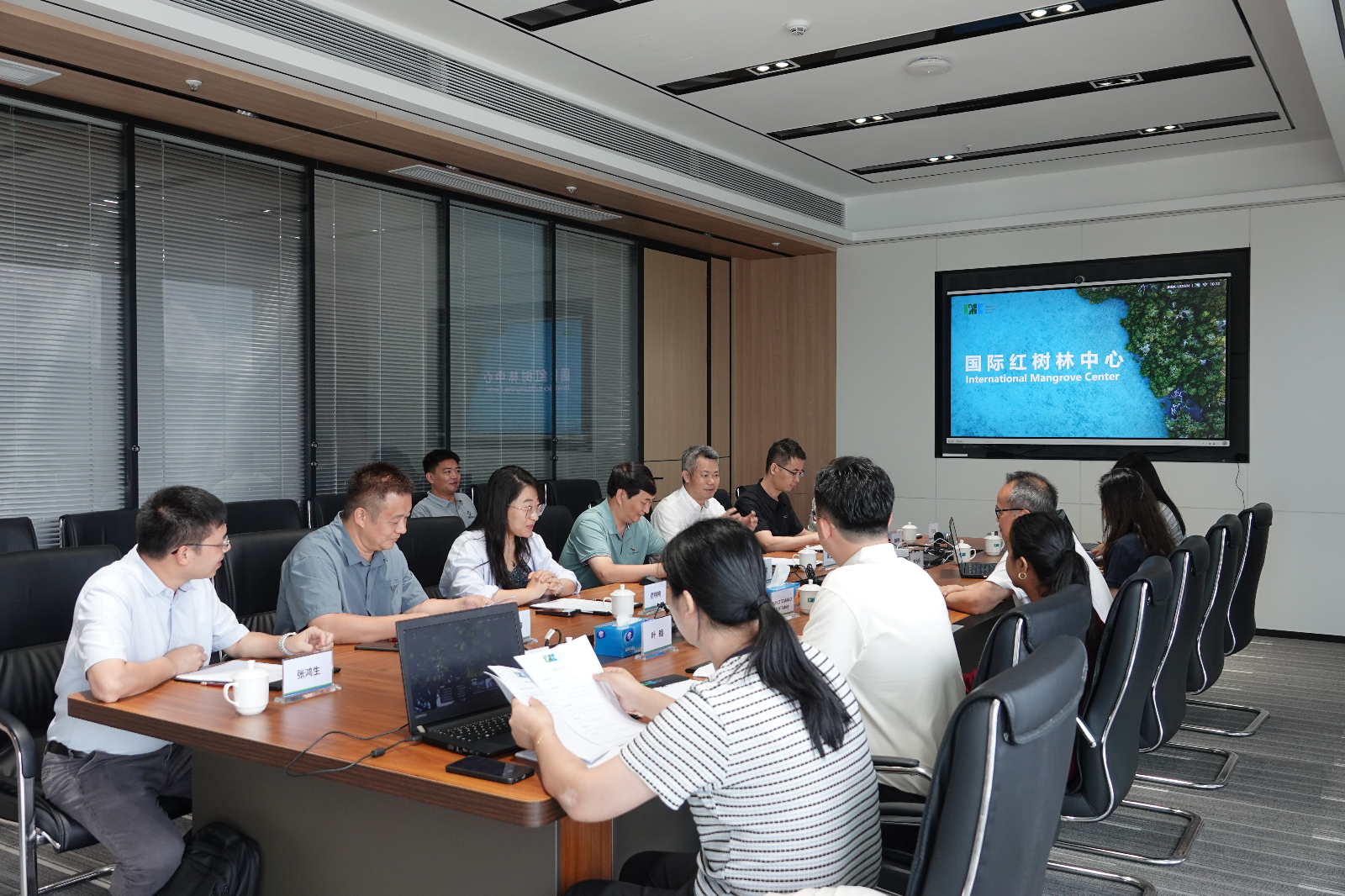Following the official communications from the Northeast Institute of Geography and Agroecology of the Chinese Academy of Sciences, the Faculty of Geographical Science at Beijing Normal University, and the Ministry of Natural Resources, the delegations undertook an exchange visit to the International Mangrove Center (IMC). The meeting aimed to foster collaboration on remote sensing monitoring of mangrove ecosystems and the assessment of their ecological functions. It provided a platform to share knowledge and experiences on mangrove ecosystem monitoring, ecological function evaluation, and wetland protection and management. The visit sought to strengthen institutional dialogue, enhance scientific and technological cooperation, and promote the sharing and application of research outcomes in support of global mangrove conservation.

Representatives from universities and research institutes engage in dialogue with the IMC Interim Secretariat
Introduction of the IMC
The Interim Secretariat presented the background information of the IMC, created following President Xi Jinping’s 2022 proposal. With the support of the National Forestry and Grassland Administration, the Shenzhen Municipal Government, and several international forums, the Ramsar Standing Committee (SC62) approved its establishment on 6 September 2023. The Establishment Agreement of the IMC was signed in Shenzhen by 18 member states on 6 November 2024.
The IMC was established to strengthen mangrove and wetland conservation. The Interim Secretariat, established and began institutional operation in December 2024, is composed of national and local staff and has already organized three Workshops on Mangrove Conservation and Restoration for 44 representatives from 21 countries. Further sessions are scheduled for September and November 2025.
The mission of the IMC, focused on promoting international cooperation and joint actions for the conservation, restoration, and wise and sustainable use of mangroves, was also presented. It currently includes 20 member states, with a governance structure comprising a Board, Secretariat, and Science and Technology Committee. Its priorities are knowledge sharing, technical cooperation, pilot projects, and capacity building.
The construction of the IMC Secretariat Building is expected to be completed by June 2026, while the Mangrove Wetland Museum is scheduled for completion in September 2028. Preparations are ongoing for the first Council meeting, scheduled for November 2025, alongside host country agreements and further international recognition processes.
At the 15th Meeting of the Conference of the Contracting Parties to the Ramsar Convention on Wetlands (COP15), held in Zimbabwe, the IMC successfully organized a side event and exhibition, highlighting its role in advancing global mangrove conservation. Its representatives actively engaged in international cooperation and promoted new memberships. Other activities included expert lectures, website development, and the recruitment of staff from Madagascar and Cambodia.
Introduction of the Department of Geographical Sciences, Beijing Normal University (BNU)
BNU presented its leadership in remote sensing science and international services, emphasizing its role in national and global research projects.
Reflections on international cooperatives research on mangrove:
Launching the International Scientific Initiative on Mangrove Conservation and Restoration
Establishing a High-Resolution Remote Sensing Consortium and an English-language journal International Mangroves
Publishing annual reports on global mangrove monitoring and high-accuracy species data
Compiling best-practice engineering projects linking conservation, restoration, and resource value transformation
Organizing recurring events such as the International Mangrove Conference and Youth Forum
Introduction of the Center for Land Satellite Remote Sensing Application, Ministry of Natural Resources
The Director of the Land Satellite Remote Sensing Application Center of the Ministry of Natural Resources gave a demonstration of the National Satellite Remote Sensing Cloud Service Platform, systematically explaining the application potential of high-resolution imagery in mangrove monitoring and ecological protection.
The Center emphasized the role of remote sensing technology in mangrove conservation, proposing the creation of a science and technology alliance and an innovation base for sustainable resource use.
China’s satellite network offers comprehensive coverage through land, ocean, radar, and high-resolution satellites, providing the IMC with one-stop monitoring services. The dialogue highlighted applications such as:
Global 2 m and sub-meter resolution monitoring for accurate mangrove mapping.
Data-sharing mechanisms to support international cooperation
Development of a multi-level data service and decision-support system for resource management.
Participants underlined the importance of combining satellite data with field verification, ensuring accurate long-term monitoring and international reporting.
Discussion and Exchanges
The open discussion focused on advancing international cooperation in mangrove monitoring and scientific research. Key points included:
Integrating satellite, drone, and technologies for high-resolution monitoring
Enhancing research on climate change impacts on mangroves
Balancing data sharing with national security through technical solutions such as data thinning
Promoting standardized reporting across IMC member states and developing a platform for data exchange
Expanding training opportunities in collaboration with universities, with a proposal for an international course in Beijing
The meeting reaffirmed the IMC’s role as a hub for global mangrove cooperation, emphasizing:
Annual mangrove monitoring and reporting for IMC member countries
Integration of carbon and blue carbon accounting into monitoring systems
Creation of a shared international data platform
Continued training, scientific exchange, and fundraising to support sustainable mangrove conservation
The session closed with agreement on the need for strengthened collaboration between IMC, universities, and research institutions to advance knowledge, capacity building, and practical conservation outcomes worldwide.